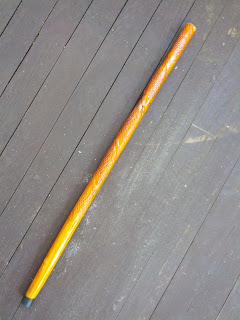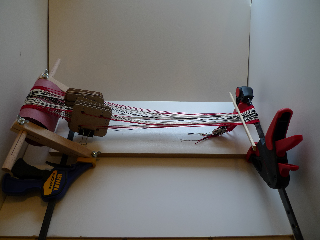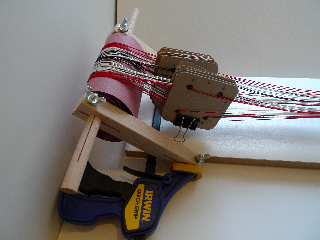Give a woman power tools, and creative things will happen (whether they were meant to be that way or not).
Some years ago I bought this little parasol:
 |
Small parasol that's lost it's handle. Hard to
date, could have been made anywhere
between 1890 and 1930. |
It was cheap. Even in its day it was must have been cheap, its construction is mediocre, its parts are economy. And your eyes do not deceive you, its handle is broken off and irretrievably lost. But that made it unloved, and cheap.
This isn't the only parasol I have that has lost its handle, but because it's such a budget frame it's going to be my first full-handle-replacement project. Over the last few weeks I've been gathering the tools and parts I need. Today I went at it (though I'm REALLY supposed to be doing
Costume College prep. Oh well.)
First thing is the replacement handle. I had originally planned to use an ordinary dowel, but went with the top end of a walking cane instead. A dowel would have had uniform thickness from top to bottom, while canes are generally a bit tapered, and that made, I think, for a more natural shape. The cane I used was *ahem* cheap, not very round, and not even meant to be used as a cane (it's only decorative). But it was a tapered stick of wood, which would do the job.
 |
What's left of the cane. I was too trigger-
happy with the saw to take a photo before
cutting it up. It has an orange stain that
would look fine, but it also has a nasty-
varnish on top. |
And now I had to solve a problem: how to drill a straight, centered hole into the end of a dowel? I explored a narrow handful of options (including buying a drill press, but I don't have anywhere to put a 100+ lbs tool), and then
Lynn McMasters said, go buy this:
 |
| My doweling jig. |
This is a doweling jig, which one uses to drill holes into the ends of planks in order to join them with dowel pins. Lynn has one that she's used to build a table, or something (Lynn is a master at technical solutions).
The doweling jig solved half the problem. I still need a way to hold the dowel itself, because if I just clamped it into the jig, the dowel would likely just rotate with the drill bit (or so I read on woodworking websites). So, I needed a dowel jig...for the doweling jig. Yeah, stay with me here.
I found the solution here:
http://www.woodworkingonline.com/2008/04/08/dowel-drilling-jig/ I just needed to adapt it for the doweling jig.
First, to drill a big hole. So happens I have these big drilling bits (don't ask why, I do a lot of DYI on my house).
 |
Big old bore drilling bits.
The big one is missing because it's stuck in the mount
(long story). |
And here's what happened.
 |
"Clamp" for the work piece on the left,
piece-to-be-clamped on the right. If I
had planned better, it wouldn't have split. |
I wanted to fix a second piece of wood at a right angle to the one with the dowel hole, so I drilled holes for two dowel pins into the piece on the right (and used the doweling jig for this, yep, it works every bit as well as advertised!) Then I went to drill two holes into the piece on the left, and, well, I tried to drill into the kerf and split the wood.
I went at it with a file to see if I could make it work anyway. I got the other dowel pin to fit, but notice here that the upright piece is at an angle.
 |
How they fit together (off-kilter; that'll need
to be fixed. |
Yeah, that's not helpful when you're trying to line things up perfectly. These are postmortem photos, and I only noticed the off-kilter angle when I took them. I'll have to fix that before I try this again.
Now to put it all together. I clamped the work piece, the new handle, into the hole, and clamped the whole thing into the doweling jig. Yes, that made quite a contraption.
 |
| All clamped together. |
 |
| Ready to drill. Here you can see the work piece. |
And here's what it looks like. Bit off center, but it'll do.
 |
| 3/8 inch bore hole for the new stick. |
 |
On the left, the new handle with new
partial stick. On the right, the frame with
a brass tube on the end, which will
connect and support the joint. |
Notice that the frame, with the tube attached, is bent. I don't know what the original frame's stick is made of but it's certainly not a great piece of wood.
At this point I need to trim the brass tube, and I want to sand the handle some more. But it was late, I was hot and hungry, and decided to call it an evening.
















